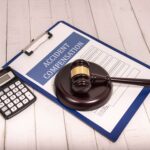Restaurant slip-and-fall accidents are all-too-common in the food service industry. From kitchens to dining areas, slippery floors are more common than they should be. If you have been injured because of this, you have the right to compensation. However, proving fault against a business entity can be complicated. A personal injury lawyer can make a big difference in helping you to receive fair compensation.
Restaurant Slip and Fall Accidents are Preventable
On a busy day, many things can cause a restaurant slip-and-fall accident. With the same reasons happening over the years, customers can now expect that the owners have already learned how to avoid such incidents.
Restaurant Slip and Fall Hazards
- Wet, freshly mopped floors
- Narrow walkways due to tables and chairs
- Obstructions (electric cords, signage)
- Grease from the kitchen
- Condensation from air conditioning
- Spilled food on footpaths
- Multiple elevations
- Poor visibility (dim lighting, glare, bright lights)
- Worn-out/ loose rugs and mats
- Poorly maintained sinks and toilets
- Changes in floor elevation
- Stairs (design and construction)
The High Cost of Restaurant Slip and Fall Accidents
The National Floor Safety Institute studied the prevalence of slip-and-fall accidents in the food service industry. According to their report, over 3 million employees and 1 million guests are injured at restaurants every year.
Moreover, the largest percentage of claims come from restaurant slip-and-fall accidents. In fact, an estimated $2 billion is spent yearly on compensation claims. The settlement numbers are rising by 10% every year. Thus, it is costing a huge amount of money from the food service industry.
But restaurant slip-and-fall accidents are also costing victims huge expenses. With severe injuries alone, medical bills could pile up to $100,000.
Why Restaurants Are Liable for Slip and Fall Accidents
There are industry guidelines to keep restaurants safe for everyone. According to restaurant.org, businesses should monitor the floor’s COF. This means coefficient of friction, the method of measurement by which floors are evaluated for their slip potential.
The COF also serves as a guide for measuring traction. There are required levels for slip resistance under dry and wet floor conditions. The American National Standards Institute (ANSI) and the National Floor Safety Institute (NFSI) have set COF standards for walking surfaces. Because more than 80% of restaurant slip-and-fall accidents happen on wet floors, slip resistance must be implemented.
In fact, NFSI proves that well-maintained floors that follow the proper COF levels have reduced slip-and-fall claims by between 50% to 90%.
Therefore, restaurant owners are aware that floors must be slip-resistant before opening for business. Thus, the responsibility for keeping the walkways safe lies in the hands of the restaurant management.
What Makes A Valid Personal Injury Case?
Restaurant slip-and-fall accidents in Arizona are included under the premises liability law. It holds business owners liable for injuries caused by their operations.
Claims for restaurant slip-and-fall accidents will only be valid if:
- The victim’s presence was legal (i.e., a customer during business hours).
- The slip-and-fall caused an actual injury.
- The restaurant management was aware of the dangerous condition.
- They did not exert any effort to correct the hazard beforehand.
- The cause of the slip-and-fall accident was preventable.
- They violated certain building codes and safety protocols.
The restaurant management, however, may use the “open and obvious” defense. This refers to the condition by which the hazard is already common knowledge to everyone. For example, due to pouring rain, anyone should expect to see a drenched entryway. Hence, customers must know this beforehand. They should be extra careful when entering the premises.
How Much Can You Get for a Slip and Fall Lawsuit
Due to the unique circumstances of each case, compensation depends on the losses caused by the injury. This may include medical bills, missed days from work, and pain and suffering, to name a few. To give you an idea, let us share one of the cases we handled as an example:
Woman Slips on a Coffee Shop Walkway
In a local coffee shop, customers need to walk to the window to order coffee. Due to the nature of its business operations, the walkway was slippery at all relevant times. Our client, the woman, slipped in its walkway while lining up for her turn. She went to the hospital via an ambulance because of a fractured ankle.
Her injuries were so severe, that her medical bills reached thousands of dollars. After her surgery procedure, the victim still suffered significant pain. She could not walk properly and needed further therapy. Such conditions prevented her from driving, working, and doing other daily activities. Hence, she sought our help to relieve her from the financial strain.
Here is how the coffee shop was proven liable:
- Despite knowing that their walkway was already slippery, management did not immediately correct the hazard.
- Without any warning signs, they failed to warn their customers about the dangerous conditions.
- Distractions such as the menu and other patrons added to the reason why the victim did not notice the slippery area.
The settlement for this case included her medical treatments, wage loss, and compensation for pain and suffering. As payment for the damages incurred, the coffee shop management agreed to settle for $134,000.
An Experienced Slip and Fall Attorney Can Help You with Your Case
Just like what we have achieved for our past clients, our attorneys at Warnock MacKinlay Law can help you receive fair compensation. If you have been the victim of a restaurant slip-and-fall accident, do not hesitate to call us now. We can start right away to help you overcome your present troubles. Call us now at 602-600-6427.








